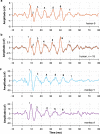Monkeys share the neurophysiological basis for encoding sound periodicities captured by the frequency-following response with humans
- PMID: 29192170
- PMCID: PMC5709359
- DOI: 10.1038/s41598-017-16774-8
Monkeys share the neurophysiological basis for encoding sound periodicities captured by the frequency-following response with humans
Abstract
The extraction and encoding of acoustical temporal regularities are fundamental for human cognitive auditory abilities such as speech or beat entrainment. Because the comparison of the neural sensitivity to temporal regularities between human and animals is fundamental to relate non-invasive measures of auditory processing to their neuronal basis, here we compared the neural representation of auditory periodicities between human and non-human primates by measuring scalp-recorded frequency-following response (FFR). We found that rhesus monkeys can resolve the spectrotemporal structure of periodic stimuli to a similar extent as humans by exhibiting a homologous FFR potential to the speech syllable /da/. The FFR in both species is robust and phase-locked to the fundamental frequency of the sound, reflecting an effective neural processing of the fast-periodic information of subsyllabic cues. Our results thus reveal a conserved neural ability to track acoustical regularities within the primate order. These findings open the possibility to study the neurophysiology of complex sound temporal processing in the macaque subcortical and cortical areas, as well as the associated experience-dependent plasticity across the auditory pathway in behaving monkeys.
Conflict of interest statement
The authors declare that they have no competing interests.
Figures





Similar articles
-
Cortical Correlates of the Auditory Frequency-Following and Onset Responses: EEG and fMRI Evidence.J Neurosci. 2017 Jan 25;37(4):830-838. doi: 10.1523/JNEUROSCI.1265-16.2016. J Neurosci. 2017. PMID: 28123019 Free PMC article.
-
Oscillatory Entrainment of the Frequency-following Response in Auditory Cortical and Subcortical Structures.J Neurosci. 2021 May 5;41(18):4073-4087. doi: 10.1523/JNEUROSCI.2313-20.2021. Epub 2021 Mar 17. J Neurosci. 2021. PMID: 33731448 Free PMC article.
-
Human Frequency Following Responses to Vocoded Speech.Ear Hear. 2017 Sep/Oct;38(5):e256-e267. doi: 10.1097/AUD.0000000000000432. Ear Hear. 2017. PMID: 28362674 Free PMC article.
-
Neural sensitivity to statistical regularities as a fundamental biological process that underlies auditory learning: the role of musical practice.Hear Res. 2014 Feb;308:122-8. doi: 10.1016/j.heares.2013.08.018. Epub 2013 Sep 12. Hear Res. 2014. PMID: 24035820 Review.
-
Evidence against attentional state modulating scalp-recorded auditory brainstem steady-state responses.Brain Res. 2015 Nov 11;1626:146-64. doi: 10.1016/j.brainres.2015.06.038. Epub 2015 Jul 14. Brain Res. 2015. PMID: 26187756 Free PMC article. Review.
Cited by
-
The amplitude in periodic neural state trajectories underlies the tempo of rhythmic tapping.PLoS Biol. 2019 Apr 8;17(4):e3000054. doi: 10.1371/journal.pbio.3000054. eCollection 2019 Apr. PLoS Biol. 2019. PMID: 30958818 Free PMC article.
-
Pre-supplementary Motor Cortex Mediates Learning Transfer from Perceptual to Motor Timing.J Neurosci. 2024 Feb 21;44(8):e3191202023. doi: 10.1523/JNEUROSCI.3191-20.2023. J Neurosci. 2024. PMID: 38123361 Free PMC article.
-
Comparison of non-invasive, scalp-recorded auditory steady-state responses in humans, rhesus monkeys, and common marmosets.Sci Rep. 2022 Jun 2;12(1):9210. doi: 10.1038/s41598-022-13228-8. Sci Rep. 2022. PMID: 35654875 Free PMC article.
-
Analyzing the FFR: A tutorial for decoding the richness of auditory function.Hear Res. 2019 Oct;382:107779. doi: 10.1016/j.heares.2019.107779. Epub 2019 Aug 8. Hear Res. 2019. PMID: 31505395 Free PMC article. Review.
-
Frequency-Following Responses to Speech Sounds Are Highly Conserved across Species and Contain Cortical Contributions.eNeuro. 2021 Dec 23;8(6):ENEURO.0451-21.2021. doi: 10.1523/ENEURO.0451-21.2021. Print 2021 Nov-Dec. eNeuro. 2021. PMID: 34799409 Free PMC article.
References
-
- Kraus, N., Anderson, S. & White-Schwoch T. The Frequency-Following Response: A Window into Human Communication (eds Kraus, N. et al.) Ch. 1, 1–15 (Springer-Nature, 2017).
Publication types
MeSH terms
LinkOut - more resources
Full Text Sources
Other Literature Sources

